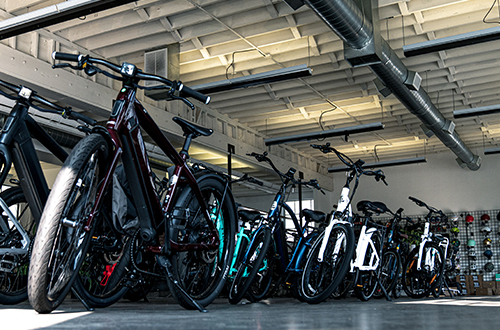El Segundo, CA 90245 (310) 640-2453
Tues - Sun: 11am - 6pm
Mon: Closed
Electric Bike Batteries Explained

Electric Bike Batteries Explained
Electric bikes are the latest craze in personal transportation. Falling somewhere between a bicycle and a motorbike, an eBike utilizes electric-powered batteries to give your pedals an extra boost. If you’re shopping for a new electric bike, you’ll probably notice that batteries have different specs and energy capacities. But what do these numbers mean exactly? Before you make your selection, here’s everything you need to know about bike batteries:
What is an eBike Battery?
A battery is essentially a portable energy source. Many of the batteries you’re used to seeing are one-time use and need to be tossed after they die. However, some batteries, like the ones that power your phone or laptop, can be recharged for multiple uses. Electric bikes utilize a similar technology. Most eBike batteries on the market today are lithium ion. Manufacturers choose this battery because it provides ample energy storage without a burdensome weight. However, not all lithium ion batteries are the same. The battery’s voltage and amps will determine its level of power and speed.
Volts, Amps, and Watt Hours
Before you select an eBike battery, you’ll need to understand volts, amps and watt hours. These numbers will help you decide if a particular model is suitable for your uses.
Volts
The speed of electrons is measured in volts (v). The voltage determines how much power the battery provides. The more power your bike has, the greater the speed.
Amps/Amp Hours
The volume of electrons is measured in amps. An amp hour (Ah) will determine how many amps the battery will use in 1 hour. The more amps, the higher the energy capacity.
Watt Hours
To really understand your eBike’s range, you need to figure out the battery’s watt hours (Wh). This measurement takes both the power (voltage) and energy capacity (amp) into account. Volts x Amps = Watts hours. Most batteries provide 300-700Wh. The higher the watt hour number, the more energy it will provide in a single hour.
For example, a 500Wh battery will be able to sustain 500w for 1 hour of use. For every additional hour, you’ll need to cut this number in half. Therefore, if you ride the bike for 2 hours, it will only be able to provide 250w per hour for this duration.
How to Maximize Your eBike Battery
A battery’s watt hour unfortunately doesn’t provide an exact estimate of how much battery life you have. Lithium ion batteries don’t burn energy evenly. The battery’s capacity depends on your usage. Rough terrain, steep hills, and extra weight will drain your battery faster. There are some things you can do to maximize your battery’s lifespan:
Reduce the Pedal Assist
The pedal assist feature is what makes eBikes so appealing. The higher the pedal assist, the less effort you’ll need to put into pedaling. However, keeping your pedal assist number at a high level will train the battery faster. To conserve energy, use the lowest setting that you’re comfortable with.
Utilize Regenerative Braking
Some bikes come with a regenerative braking system. When you come to a slow and even stop, the friction produces energy to charge the battery. This feature can help extend the battery life and give you a bit more range.
Charge Your Battery Appropriately
If you can, try not to let your eBike battery discharge down below 30%. Doing so will decrease the battery’s lifespan. When you do charge the battery, don’t let it reach max voltage. This will degrade the battery. However, you should charge your electric bike battery to full capacity every few weeks to balance the cells.
Have More Battery Questions? Electric Bikes LA Has the Answers
New to electric bicycles? Welcome to the family! Whether you’re a rookie or veteran rider, Electric Bikes LA is here for all your eBike needs. We understand that eBike batteries can be confusing. Rest assured, our experienced Bike Advisors will guide through your shopping experience. Visit our shop to see our eBikes in action.


